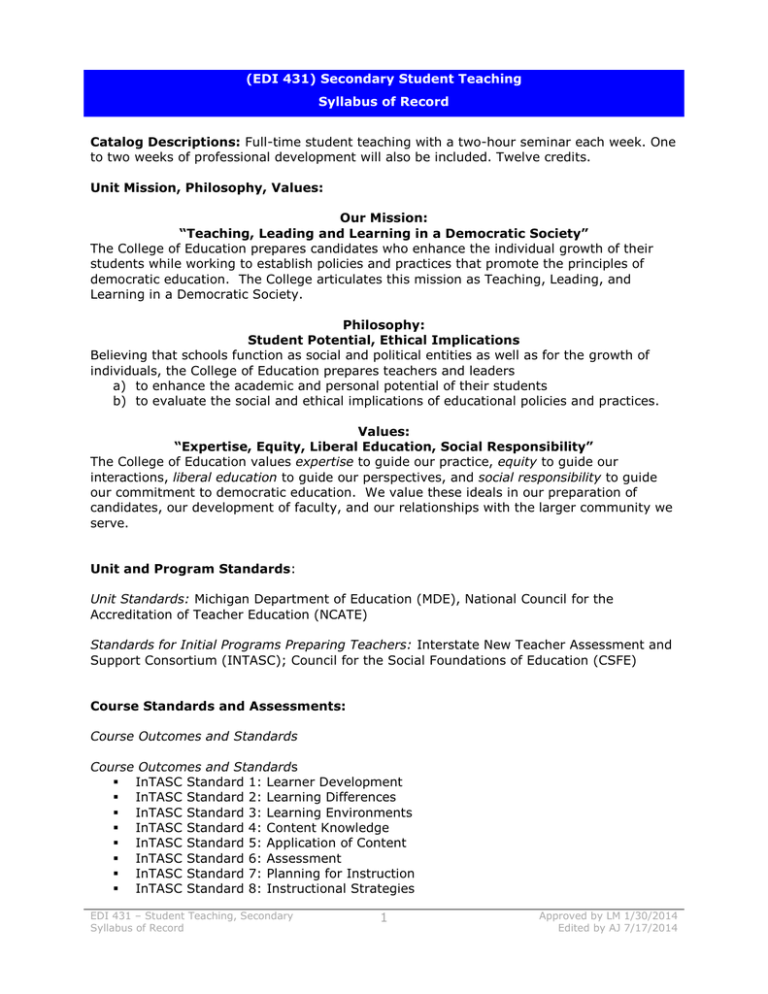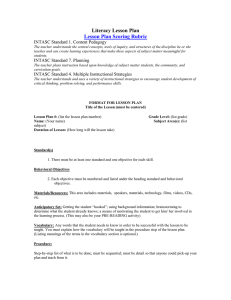(EDI 431) Secondary Student Teaching Syllabus of Record Catalog Descriptions:
advertisement

(EDI 431) Secondary Student Teaching Syllabus of Record Catalog Descriptions: Full-time student teaching with a two-hour seminar each week. One to two weeks of professional development will also be included. Twelve credits. Unit Mission, Philosophy, Values: Our Mission: “Teaching, Leading and Learning in a Democratic Society” The College of Education prepares candidates who enhance the individual growth of their students while working to establish policies and practices that promote the principles of democratic education. The College articulates this mission as Teaching, Leading, and Learning in a Democratic Society. Philosophy: Student Potential, Ethical Implications Believing that schools function as social and political entities as well as for the growth of individuals, the College of Education prepares teachers and leaders a) to enhance the academic and personal potential of their students b) to evaluate the social and ethical implications of educational policies and practices. Values: “Expertise, Equity, Liberal Education, Social Responsibility” The College of Education values expertise to guide our practice, equity to guide our interactions, liberal education to guide our perspectives, and social responsibility to guide our commitment to democratic education. We value these ideals in our preparation of candidates, our development of faculty, and our relationships with the larger community we serve. Unit and Program Standards: Unit Standards: Michigan Department of Education (MDE), National Council for the Accreditation of Teacher Education (NCATE) Standards for Initial Programs Preparing Teachers: Interstate New Teacher Assessment and Support Consortium (INTASC); Council for the Social Foundations of Education (CSFE) Course Standards and Assessments: Course Outcomes and Standards Course Outcomes and Standards InTASC Standard 1: Learner Development InTASC Standard 2: Learning Differences InTASC Standard 3: Learning Environments InTASC Standard 4: Content Knowledge InTASC Standard 5: Application of Content InTASC Standard 6: Assessment InTASC Standard 7: Planning for Instruction InTASC Standard 8: Instructional Strategies EDI 431 – Student Teaching, Secondary Syllabus of Record 1 Approved by LM 1/30/2014 Edited by AJ 7/17/2014 InTASC Standard 9: Professional Learning and Ethical Practice InTASC Standard 10: Leadership and Collaboration Common Assessment: Academic Professional Development Folio—Second Field Practicum Performance Evaluation Major Topics: Application of Discipline Knowledge & Understanding Demonstrating Understanding Student Development and Responsiveness During Lessons Creating Respectful Learning Environments including Instructional Variety Effective Communication Skills Instruction and Curriculum Planning Assessment: Learners & Strategies Reflective Practice Social Responsibility: Colleagues and Community Course Knowledge Base: Armstrong, D. (1998). Teaching in the secondary school: An introduction. (4th ed). Upper Saddle River, NJ: Merrill/Prentice Hall. Burke, Kay. What to do with the kid who… Illinois: 2000. Skylight Professional Development. Callahan, J. & Clark, L. (1998). Teaching in the middle and secondary schools: Planning for competence (3rd ed.). NY: Macmillan. Case, J. & Harris, D. (2001). Succeeding with standards: Linking curriculum, assessment, and action planning. Alexandria, VA: Association for Supervision and Curriculum Development. Charles, C. (2007). Building classroom discipline (9th ed.). Boston: Pearson/Allyn & Bacon. 2004. Danielson, C. (2005). Enhancing professional practice: A framework for teaching (2nded.). Alexandria, VA. Association for Supervision and Curriculum Development. Danielson, C. (2000). Teacher evaluation: To enhance professional practice. Alexandria, VA: Association for Supervision and Curriculum Development. Dickinson, T. & Orb, T. (1997). (Eds.). We gain more than we give: schools. Columbus, OH: National Middle School Association. Teaming in middle Glasser, William. (1998). Choice theory. New York: Harper Perennial. Grassman, Herbert. (1995). Classroom behavior management in a diverse society. Mountain View, Ca: Mayfield Publishing. EDI 431 – Student Teaching, Secondary Syllabus of Record 2 Approved by LM 1/30/2014 Edited by AJ 7/17/2014 Jackson, A. & Davis, G. (2000). Turning points 2000: Educating adolescents in the 21 st century. NY: Teachers College Press Columbia University. Joyce, B. &B Weil, M. (1996). Models of teaching. (5th ed.). Boston: Allyn & Bacon. Kohn, Alfie. (1999). The schools our children deserve. New York: Houghton Mifflin. Michigan Board of Education. (1996). Michigan curriculum framework. Lansing, MI: Michigan Department of Education. Michigan League for Human Services. (1996). Starting again in the middle: The middle start initiative Lansing, MI: Michigan League for Human Services [author]. Moore, K. S. (1999). Middle and secondary school instructional methods (2 nd ed.). NY: McGraw-Hill. Orllich D., Harder, R., Callahan, R. & Gibson, H. (2001). Teaching strategies: A guide to better instruction (6th ed.). Boston: Houghton Mifflin Company. Walker, J. E. (1995). Behavior management. Merrill: Prentice-Hall. Wong, H. & Wong, R. (1998). The first days of school. California: Publications. Harry K. Wong Web Sites: American Association of School Administrators: www.aasa.org American Association of Colleges for Teacher Education: www.aacte.org/ Association for Supervision and Curriculum: www.ascd.org Association of Teacher Educators: www.ate1.org/ Michigan Department of Education: www.mde.state.mi.us U.S. Department of Education: www.ed.gov EDI 431 – Student Teaching, Secondary Syllabus of Record 3 Approved by LM 1/30/2014 Edited by AJ 7/17/2014
